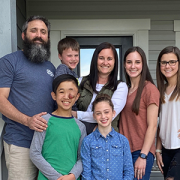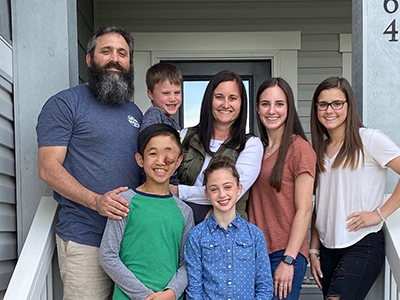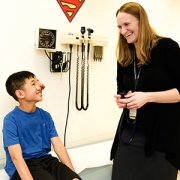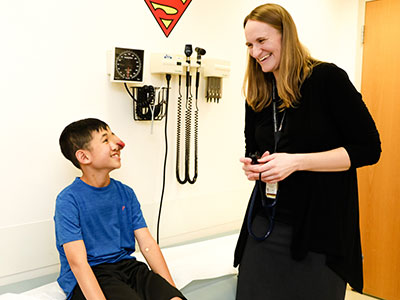Miriam Bornhorst, M.D., receives DOD New Investigator Award

Miriam Bornhorst, M.D., clinical director of the Gilbert Neurofibromatosis Institute at Children’s National Hospital, received the Department of Defense’s Neurofibromatosis Research Program New Investigator Award.
This award, which is funded by the U.S. Department of Defense, has granted $450,000 in funds which Dr. Bornhorst hopes to use towards a study for patients with Neurofibromatosis Type 1 (NF1).
“There is very little known about metabolism in NF1, but we know that abnormalities in metabolism can not only affect a person’s overall health, but may also influence how tumors develop and grow,” Dr. Bornhorst explained.
Patients with NF1 can have defining clinical features related to growth and energy metabolism, such as short stature, low weight and decreased bone mineral density, findings that are more prominent in patients with high plexiform neurofibroma (a nerve sheath tumor) burden. The mechanism for this metabolic phenotype and its association with plexiform neurofibromas is not currently understood.
Preliminary data and the work of others suggest that the MAPK pathway may play a role in metabolism and Mek-inhibitor (MEKi) treatment, which decreases activity of the MAPK pathway and promotes weight gain in patients with NF1. Dr. Bornhorst’s study will be the first to explore global metabolism in NF1, determine which metabolic pathways are most active in plexiform neurofibromas and define how metabolomic signatures change during MEKi treatment.
“These findings will improve management and may lead to novel treatment options for patients with NF1,” she said. “It is my hope that the grant funding received for my study will not only allow me to generate data that will answer questions about metabolism in NF1, but foster interest in this topic so there are more opportunities for researchers in the future.”
The NFRP was initiated in 1996 to provide support for research of exceptional scientific merit that promotes the understanding, diagnosis, and treatment of neurofibromatosis (NF) including NF type 1 (NF1) and type 2 (NF2) and schwannomatosis. Since it was first offered, 346 new Investigator Award applications have been received and only 79 have been recommended for funding – with Children’s National receiving one in the latest grant cycle. The Gilbert Family Neurofibromatosis Institute at Children’s National is one of the world’s largest programs and the longest standing program in the United States.
Opinions, interpretations, conclusions and recommendations are those of the author and are not necessarily endorsed by the Department of Defense.







